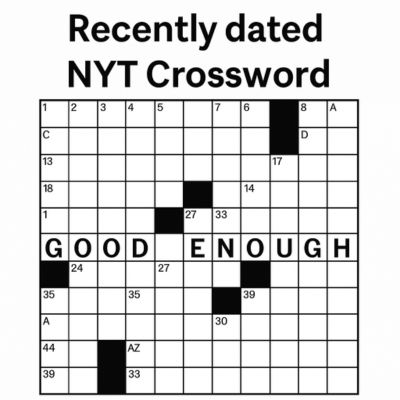On the August 28 2025 edition of the New York Times crossword puzzle, the clue “Recently dated” appeared at 17-Across. The answer: GOOD ENOUGH — a response that puzzled many solvers at first glance. After all, “recently dated” might normally suggest “just gone on a date” or “newly paired.” But once the solver spotted the puzzle’s theme — spoonerisms — the logic clicked. “Recently dated” becomes a spoonerism of “decently rated,” and that in turn defines GOOD ENOUGH.
This is the magic of the NYT crossword: layers of wordplay hidden beneath seemingly ordinary clues. “Recently dated” isn’t simply about relationships; it’s about phonetic play, misdirection, and the joy of the “aha!” moment.
The Thematic Framework
The puzzle’s theme is revealed by a meta clue near the bottom of the grid: “Feature of the clues for 17-, 25-, 41-, and 52-Across: SPOONERISM.” That one word — “spoonerism” — changes everything.
Each of those long across clues is an example of sound-swapping wordplay. In simple terms, a spoonerism swaps the initial sounds of two words to create a new phrase or meaning. Reverend William Spooner, a 19th-century Oxford don, was famous for this verbal slip — saying things like “you have hissed all my mystery lectures” instead of “missed all my history lectures.”
In the August 2025 NYT puzzle, four clues used this gimmick:
- 17-Across: Recently dated → “decently rated” → GOOD ENOUGH
- 25-Across: No guts → “go nuts” → FREAK OUT
- 41-Across: Battle carriers → “cattle barriers” → CHAIN-LINK FENCES
- 52-Across: Packed lunch → “lacked punch” → FELL FLAT
Each clue’s surface meaning feels logical, yet the real trick lies in recognizing the spoonerized phrase. Once you decode the pattern, the answers fall into place — and solvers experience the thrill of discovery.
Why “Recently Dated” Stands Out
Among these theme clues, “Recently dated” shines as the standout. Its brilliance lies in its simplicity.
- Surface Misleading: At first glance, it sounds like a social clue — perhaps about romantic relationships or time frames. The solver naturally thinks of phrases like “just went out with” or “newly coupled.”
- Spoonerism Precision: Once the theme is revealed, flipping the initial sounds yields “decently rated,” a perfect synonym for GOOD ENOUGH.
- Accessibility: “GOOD ENOUGH” is a common, friendly phrase. It doesn’t rely on obscure trivia or forced wordplay.
- Fairness: The meta clue “SPOONERISM” ensures solvers aren’t unfairly misled. Even if the solver doesn’t see the trick right away, there’s a fair path to discovery.
In short, this clue delivers the ideal crossword balance: wit, fairness, and surprise.
Community Reaction and Solver Insight
Crossword communities thrive on discussion. On solver blogs and puzzle forums, “Recently dated” drew immediate attention. Many solvers reported double-takes — some laughed at the cleverness, others admired the elegance of the theme. A few beginners admitted they were momentarily stuck until the meta clue “SPOONERISM” guided them.
What stood out in feedback:
- Accessibility: Even newer solvers could enjoy it once the mechanism clicked.
- Satisfaction: The “aha” moment was widely appreciated — the clue was tricky but fair.
- Theme coherence: Every themed clue followed the same pattern, building consistency across the puzzle.
Experienced solvers praised it as an example of “classic NYT cleverness,” while constructors highlighted its restraint — it doesn’t overreach, yet it delivers a memorable payoff.
Lessons for Crossword Writers and Solvers
For Solvers
- Always read for theme hints. If a puzzle includes a meta clue (like “SPOONERISM” or “wordplay theme”), it’s your key to unlocking the grid.
- Don’t trust surface meaning. Words like “recently dated” may look ordinary, but in themed puzzles, they often conceal sound or letter tricks.
- Think phonetically. Themes like spoonerisms, puns, and homophones rely on sound, not spelling. Reading clues aloud can reveal hidden patterns.
- Practice recognition. Many NYT puzzles repeat these devices — the more you encounter them, the quicker you’ll spot them next time.
For Constructors
- Clarity through misdirection. “Recently dated” is clever because it’s natural on the surface yet transforms elegantly with a sound swap.
- Use familiar phrases. “GOOD ENOUGH” works because solvers instantly recognize it. Obscure answers would make the clue frustrating.
- Guide the solver. The meta indicator “SPOONERISM” ensures fairness and broad enjoyment.
- Maintain thematic integrity. Each theme entry in this puzzle used the same mechanism — consistency enhances solver satisfaction.
For constructors aiming to create memorable puzzles, “Recently dated” should be studied as a model of elegant clue-writing and thematic cohesion.
The Broader Context: NYT Crossword Tradition
The New York Times crossword has long been the gold standard of American puzzles. Edited for decades by Will Shortz, it maintains a reputation for cleverness, fairness, and wordplay innovation. Every day’s puzzle caters to a particular difficulty level — Mondays being easiest, Saturdays hardest, and Sundays the grand showcase.
The August 28 2025 puzzle exemplifies Thursday-level trickery: conceptual, not purely difficult. Thursdays often feature rebuses, puns, or sound-based gimmicks. “Recently dated” fits this profile perfectly.
Moreover, this clue underscores how the NYT crossword has evolved. Earlier decades leaned on trivia and definitions. Modern puzzles emphasize themes, puns, and word-play — challenges that reward lateral thinking over rote knowledge.
Crossword fans now gather online, sharing commentary, times, and even solving together in forums. Clues like “Recently dated” spark these communal conversations. Solvers debate whether the clue is elegant or cheeky, whether it fooled them or they caught it early. This interactive ecosystem is what keeps crosswords alive and relevant.
Why This Puzzle Resonates
The August 2025 puzzle wasn’t just another Thursday challenge. It represented the harmony of modern puzzle design:
- Playful without being punishing.
- Clever but fair.
- Accessible yet rewarding.
“Recently dated” sits at the center of that harmony. It turns a familiar phrase into a linguistic trick — something any English speaker can appreciate once the light bulb flickers on.
It’s also a miniature lesson in the evolution of language. Spoonerisms themselves rely on our brain’s tolerance for sound manipulation. They’re funny, surprising, and cognitively satisfying because they violate expectation in a controlled way. Crossword puzzles capitalize on that same neural delight: the thrill of pattern recognition.
Crosswords as Cognitive Art
Every good crossword clue, especially one like “Recently dated,” engages both hemispheres of the brain. The left side processes literal meaning; the right side interprets figurative or phonetic play. When a solver realizes “Recently dated” → “decently rated,” it triggers a spark of insight — the brain’s reward system fires, releasing dopamine.
That’s why solving crosswords feels addictive: you’re literally rewarding your brain with moments of clarity.
The NYT crossword, more than any other, has mastered the art of packaging those moments. It’s not just about filling boxes; it’s about discovering meaning through structure. Each clue is a tiny riddle that rewards curiosity and persistence.
A Reflection on Language and Humor
Spoonerisms are inherently humorous because they subvert our linguistic expectations. They also reveal how fragile and flexible language can be. When Reverend Spooner accidentally swapped sounds in sermons, people laughed — but also recognized the playful power of speech.
“Recently dated,” in its puzzle form, inherits that humor. It invites solvers to momentarily misinterpret, then laugh at their own misdirection. The humor isn’t forced; it emerges naturally once the trick is uncovered.
That’s why such clues endure in crossword lore. They remind us that language is both serious and silly — that wordplay is an art form, not a gimmick.
From Page to Community: Why Solvers Care
Beyond the grid, the New York Times crossword has built a vibrant community of fans who discuss clues daily, analyze trends, and even critique editorial choices. Clues like “Recently dated” become talking points — dissected, celebrated, and archived.
For puzzle enthusiasts, such clues aren’t throwaways. They’re small masterpieces of linguistic engineering. They show how creativity, humor, and clarity can coexist in a few short words.
Crossword culture has evolved into something akin to literature analysis. Solvers don’t just “get the answer” — they interpret meaning, evaluate elegance, and share the experience. “Recently dated” exemplifies this modern interplay between constructor, editor, and audience.
Conclusion: Why “Recently Dated” Matters
In the landscape of crossword construction, “Recently dated” is a masterstroke. It captures the essence of the NYT puzzle ethos — witty, challenging, but never cruel. Its clever spoonerism mechanism demonstrates how phonetic play can produce satisfying, memorable solving moments.
For solvers, it’s a reminder to listen to language, not just read it. For constructors, it’s a template for elegant theme execution. For puzzle fans, it’s another reason to celebrate the living art of the crossword.
And for readers of Buz Vista, this article underscores why word-play, puzzles, and language exploration continue to fascinate us — not just as entertainment, but as insight into how we think, speak, and find joy in discovery.
1. What does “Recently dated” mean in the NYT crossword?
In the August 28, 2025 New York Times crossword, “Recently dated” was part of a themed puzzle involving spoonerisms. The clue is a word-play version of “decently rated,” which leads to the answer GOOD ENOUGH. It’s not about romance but about sound-swapping word-play.
2. What is a spoonerism in crossword puzzles?
A spoonerism is when the initial sounds of two words are swapped to create a new phrase. For example, “decently rated” becomes “recently dated.” It’s a playful linguistic trick used by constructors to add humor and complexity.
3. When did the “Recently dated” clue appear in the NYT crossword?
The clue “Recently dated” appeared on August 28, 2025, in a Thursday puzzle. Thursday crosswords are known for having clever twists and themes, such as puns, word swaps, or rebuses.
4. Who creates NYT crossword puzzles?
The puzzles are edited by Will Shortz, who has been the crossword editor of The New York Times since 1993. The constructors vary daily — individual creators submit puzzles, which Shortz and his team review, test, and edit.
5. What day of the week is the hardest NYT crossword?
Traditionally, Monday puzzles are the easiest, while Saturday puzzles are the hardest. Thursday puzzles, like the one with “Recently dated,” are known for their trickiness — often featuring themes or wordplay rather than pure difficulty.
6. Why do people enjoy solving NYT crosswords?
Solving crosswords engages both logic and creativity. Many solvers love the “aha!” moment when a tricky clue suddenly makes sense — like realizing that “Recently dated” isn’t about relationships but a sound-based pun.
7. Are spoonerism clues common in NYT crosswords?
They appear occasionally, especially on themed days like Thursday. They’re not everyday clues, but when used, they’re remembered for their cleverness and humor.
8. What are some similar themed clues?
Similar clues from the same puzzle include:
- “No guts” → “go nuts” → FREAK OUT
- “Battle carriers” → “cattle barriers” → CHAIN-LINK FENCES
- “Packed lunch” → “lacked punch” → FELL FLAT
Each one uses the same spoonerism theme, demonstrating the constructor’s consistency.
9. How can I get better at solving NYT crosswords?
- Start with Monday puzzles and work upward.
- Pay attention to themes and wordplay indicators.
- Learn common clue conventions and abbreviations.
- Follow crossword blogs and solver communities for insights and explanations.
10. Where can I read more crossword breakdowns like this?
You can explore more puzzle insights, breakdowns, and crossword-related articles on Buz Vista, where we dive deep into word-play, puzzle design, and linguistic creativity.

